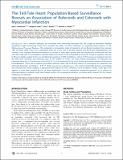The tell-tale heart: population-based surveillance reveals an association of rofecoxib and celecoxib with myocardial infarction

View/
Published Version
https://doi.org/10.1371/journal.pone.0000840Metadata
Show full item recordCitation
Brownstein, John S., Margarita Sordo, Isaac S. Kohane, and Kenneth D. Mandl. 2007. The tell-tale heart: population-based surveillance reveals an association of rofecoxib and celecoxib with myocardial infarction. PLoS ONE 2(9): e840.Abstract
Background: COX-2 selective inhibitors are associated with myocardial infarction (MI). We sought to determine whether population health monitoring would have revealed the effect of COX-2 inhibitors on population-level patterns of MI. Methodology/Principal Findings: We conducted a retrospective study of inpatients at two Boston hospitals, from January 1997 to March 2006. There was a population-level rise in the rate of MI that reached 52.0 MI-related hospitalizations per 100,000 (a two standard deviation exceedence) in January of 2000, eight months after the introduction of rofecoxib and one year after celecoxib. The exceedence vanished within one month of the withdrawal of rofecoxib. Trends in inpatient stay due to MI were tightly coupled to the rise and fall of prescriptions of COX-2 inhibitors, with an 18.5% increase in inpatient stays for MI when both rofecoxib and celecoxib were on the market (P<0.001). For every million prescriptions of rofecoxib and celecoxib, there was a 0.5% increase in MI (95%CI 0.1 to 0.9) explaining 50.3% of the deviance in yearly variation of MI-related hospitalizations. There was a negative association between mean age at MI and volume of prescriptions for celecoxib and rofecoxib (Spearman correlation, −0.67, P<0.05). Conclusions/Significance: The strong relationship between prescribing and outcome time series supports a population-level impact of COX-2 inhibitors on MI incidence. Further, mean age at MI appears to have been lowered by use of these medications. Use of a population monitoring approach as an adjunct to pharmacovigilence methods might have helped confirm the suspected association, providing earlier support for the market withdrawal of rofecoxib.Other Sources
http://www.ncbi.nlm.nih.gov/pmc/articles/PMC1950690/pdf/Terms of Use
This article is made available under the terms and conditions applicable to Other Posted Material, as set forth at http://nrs.harvard.edu/urn-3:HUL.InstRepos:dash.current.terms-of-use#LAACitable link to this page
http://nrs.harvard.edu/urn-3:HUL.InstRepos:4875879
Collections
- HMS Scholarly Articles [17922]
Contact administrator regarding this item (to report mistakes or request changes)


